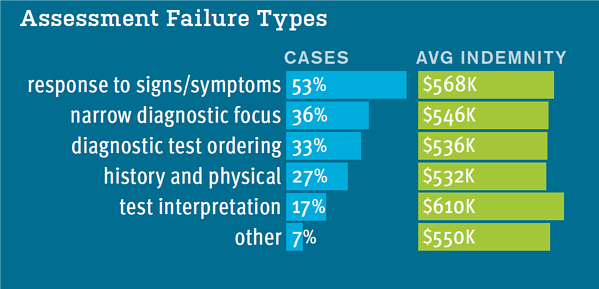Missteps in a clinician’s patient assessment process are frequently at the root of high-impact adverse events that result in medical malpractice claims that have a higher than average likelihood of closing with an indemnity payment. These cases are most commonly diagnosis related (40%)—especially missed cancers. More than half of these cases result in a high-severity injury (27%) or the patient’s death (29%).

These data demonstrate a need to convey the clinical and insurance consequences of patient assessment breakdowns in failure-to-diagnoses cancer cases. But even with credible evidence, a communication mechanism that prompts changes to clinical practice and systems is needed. Education programs can be effective, but retention is required for long-term benefits. And while peer-review journal articles are important, they take a long time to publish (and read).
Clinical practice guidelines—or algorithms—have an established role in medicine. Decision support tools (DST) are clinical guidelines with risk management and patient safety components.
ARE YOU USING CLINICAL GUIDELINES?
In a recent CRICO Strategies webinar, an audience poll asked about current use and promotion of guidelines. We were pleased to see that the majority of attendees promote the value of using guidelines (65%), and not surprised to see that just five percent produce their own. CRICO has long produced its decision support tools and understands that the process is lengthy, resource intensive…and worthwhile.
For more than 20 years, CRICO, the captive insurer of the Harvard medical institutions, has developed decision support tools for the management of patients at risk for colon or breast cancer. They continue to be well received and are considered key to stabilizing failure-to-diagnose cancer cases and losses. The process CRICO uses for development of decision support tools includes:
- Seeking frontline experience to prompt investigation of patient safety risks
- Motivating change by providing more than anecdotes
- Employing medical professional liability (MPL) data and case examples from Candello to consolidate the understanding of risk
- Guiding clinically-driven practice with an eye toward patient safety risks via DST
- Collaborating with respected authors and reviewers
- Keeping current and flexible
CAN CLINICAL GUIDELINES MITIGATE THE RISK OF DIAGNOSTIC FAILURE?
The short answer is yes. The caveat is that, for clinicians to respect and embrace them, guidelines need to be based on credible evidence and generated by a trusted source. Since many organizations may not have the resources to self produce; below are key considerations when looking for guidelines that you can promote.
- How were the guidelines developed? Is it clear who developed and published the guideline? What clinical roles were involved in the research, writing and review? Was there a legal review process?. This information should be transparent so you can better understand the basis for the recommendations put forth in the guidelines.
- How current are the guidelines? Clinical care changes and guidelines must be kept current, both in terms of clinical practice and in alignment with legal risks.
- Can your internal systems support the recommendations with in the guidelines? For example, do your collection of history, scheduling, referrals, provider-provider communication, etc. support recommendations that are put forth in the guidelines? If not, this could cause confusion and frustration among your clinicians.
- Do you have an effective way of getting the guidelines into the hands of the most appropriate clinicians? Guidelines intended to help mitigate missed or delayed diagnoses are helpful to the providers seeing the patients at the onset of the diagnostic process (i.e., primary care providers). You need to be able to communicate guidelines to these front-line clinicians where they can best be applied.
A recording of the webinar, Can Clinical Guidelines Mitigate the Risk of Diagnostic Failure? can be viewed here.

